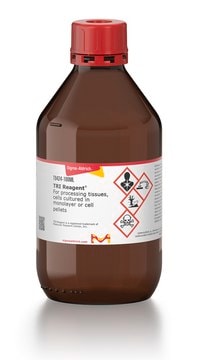496189
Chloroform
biotech. grade, ≥99.8%, contains 0.5-1.0% ethanol as stabilizer
Synonym(s):
Methylidyne trichloride, Trichloromethane
About This Item
Recommended Products
grade
biotech. grade
Quality Level
vapor density
4.1 (vs air)
vapor pressure
160 mmHg ( 20 °C)
Assay
≥99.8%
form
liquid
contains
0.5-1.0% ethanol as stabilizer
impurities
<0.01% water
evapn. residue
<0.0003%
color
APHA: ≤10
refractive index
n20/D 1.445 (lit.)
pH
5.2-6.4
bp
60.5-61.5 °C (lit.)
mp
−63 °C (lit.)
density
1.48 g/mL at 25 °C
1.492 g/mL at 25 °C (lit.)
cation traces
Pb: ≤0.05 ppm
SMILES string
ClC(Cl)Cl
InChI
1S/CHCl3/c2-1(3)4/h1H
InChI key
HEDRZPFGACZZDS-UHFFFAOYSA-N
Looking for similar products? Visit Product Comparison Guide
General description
Application
- Synthesis of colloidal hydrophobic CdSe core nanocrystals (quantum dots).
- Preparing phospholipid solutions.
- As a solvent in the photolysis reaction of ruthenium complexes.
- Solvent for recrystallization.
- Reference compound to detect the presence of chloroform in Tobacco smokes.
- Extractant in solvent extraction process.
Signal Word
Danger
Hazard Statements
Precautionary Statements
Hazard Classifications
Acute Tox. 3 Inhalation - Acute Tox. 4 Oral - Carc. 2 - Eye Irrit. 2 - Repr. 2 - Skin Irrit. 2 - STOT RE 1 Oral - STOT SE 3
Target Organs
Central nervous system, Liver,Kidney
Storage Class Code
6.1D - Non-combustible acute toxic Cat.3 / toxic hazardous materials or hazardous materials causing chronic effects
WGK
WGK 3
Flash Point(F)
does not flash
Flash Point(C)
does not flash
Certificates of Analysis (COA)
Search for Certificates of Analysis (COA) by entering the products Lot/Batch Number. Lot and Batch Numbers can be found on a product’s label following the words ‘Lot’ or ‘Batch’.
Already Own This Product?
Find documentation for the products that you have recently purchased in the Document Library.
Customers Also Viewed
Our team of scientists has experience in all areas of research including Life Science, Material Science, Chemical Synthesis, Chromatography, Analytical and many others.
Contact Technical Service





